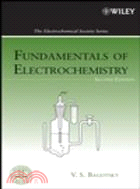| FindBook |
有 1 項符合
FUNDAMENTALS OF ELECTROCHEMISTRY 2E的圖書 |
 |
FUNDAMENTALS OF ELECTROCHEMISTRY 2E 作者:BAGOTSKY 出版社:JOHN WILEY & SONS INC 出版日期:2005-11-25 |
| 圖書館借閱 |
| 國家圖書館 | 全國圖書書目資訊網 | 國立公共資訊圖書館 | 電子書服務平台 | MetaCat 跨館整合查詢 |
| 臺北市立圖書館 | 新北市立圖書館 | 基隆市公共圖書館 | 桃園市立圖書館 | 新竹縣公共圖書館 |
| 苗栗縣立圖書館 | 臺中市立圖書館 | 彰化縣公共圖書館 | 南投縣文化局 | 雲林縣公共圖書館 |
| 嘉義縣圖書館 | 臺南市立圖書館 | 高雄市立圖書館 | 屏東縣公共圖書館 | 宜蘭縣公共圖書館 |
| 花蓮縣文化局 | 臺東縣文化處 |
|
|
- 圖書簡介
Fundamentals of Electrochemistry provides the basic outline of most topics of theoretical and applied electrochemistry for students not yet familiar with this field, as well as an outline of recent and advanced developments in electrochemistry for people who are already dealing with electrochemical problems.
The content of this edition is arranged so that all basic information is contained in the first part of the book, which is now rewritten and simplified in order to make it more accessible and used as a textbook for undergraduate students. More advanced topics, of interest for postgraduate levels, come in the subsequent parts.
This updated second edition focuses on experimental techniques, including a comprehensive chapter on physical methods for the investigation of electrode surfaces. New chapters deal with recent trends in electrochemistry, including nano- and micro-electrochemistry, solid-state electrochemistry, and electrocatalysis. In addition, the authors take into account the worldwide renewal of interest for the problem of fuel cells and include chapters on batteries, fuel cells, and double layer capacitors. - 作者簡介
VLADIMIR S. BAGOTSKY, PHD, is a retired professor from the Frumkin Institute of Electrochemistry at the Russian Academy of Sciences, Moscow. Previously, he headed a department at the Moscow Power Sources Institute, where he supervised the development of new batteries for most Russian ICBMs, sputniks, and spacecrafts. He has extensive experience with both theoretical and applied electrochemistry. He has authored 400 scientific papers and four monographs, including, in 1952 (together with Professor A. N. Frumkin et al.), the first monograph on electrochemical kinetics, titled Kinetics of Electrode Processes, and served on the editorial boards of Journal of Power Sources and Elektrokhimiya.
- 目次
Contributors.
Preface to the Second Edition.
Preface to the First Edition.
List of Photographs.
Abbreviations.
Symbols.
PART I: BASIC CONCEPTS.
1. Electric Currents in Ionic Conductors.
1.1 Various Types of Conductors.
1.2 Ions in Electrolyte Solutions.
1.3 Conductivity of Electrolyte Solutions.
1.4 Circuits Involving Ionic Conductors. Electrodes.
1.5 Passage of Current Through Electrodes. Electrode Reactions.
1.6 Classification of Electrodes and Electrode Reactions.
1.7 Faraday’s Laws.
1.8 Equations for Mass Balance.
1.9 Sign Convention for Currents and Fluxes.
2. Electrode Potentials.
2.1 Interfacial Potential Differences (Galvani Potentials).
2.2 Exchange Currents.
2.3 Open-Circuit Voltages.
2.4 Electrode Potentials.
2.5 Cell Voltage at Nonzero Current.
3. Thermodynamics of Electrochemical Systems.
3.1 Conventional and Undefined Parameters.
3.2 Thermodynamic Functions in Electrochemistry.
3.3 Thermodynamic Activity.
3.4 Equations for the EMF of Galvanic Cells.
3.5 Concentration Dependence of Electrode Potentials.
3.6 Special Thermodynamic Features of Electrode Potentials.
4. Mass Transfer in Electrolytes.
4.1 Basic Laws of Ionic Diffusion in Solutions.
4.2 Limiting Diffusion Currents in Electrolytes.
4.3 Ionic Transport by Migration and Diffusion.
4.4 Convective Transport.
5. Phase Boundaries (Interfaces) Between Miscible Electrolytes.
5.1 Types of Interfaces Between Electrolytes.
5.2 Potentials Between Similar Electrolytes (Diffusion Potentials).
5.3 Distribution of the Ions Between Dissimilar but Miscible Electrolytes.
5.4 Distribution of Ions in Cells with Membrane.
5.5 Galvanic Cells with Transference.
6. Polarization of Electrodes.
6.1 Basic Concepts.
6.2 Laws of Activation Polarization.
6.3 Diffusional Concentration Polarization.
6.4 Superposition of Concentration and Activation Polarization.
7. Aqueous Electrolyte Solutions.
7.1 Electrolytic Dissociation.
7.2 Ionic Solvation (Hydration) in Solutions.
7.3 Activity of Real Electrolyte Solutions.
7.4 Physical Theories of Ion–Ion Interactions.
8. Nonaqueous Electrolytes.
8.1 Different Types of Electrolytes and Their Practicalb Utilization.
8.2 Nonaqueous Electrolyte Solutions.
8.3 Ionically Conducting Melts.
8.4 Inorganic Solid Electrolytes.
9. Electron Work Functions and Volta Potentials. 10. Structure and Properties of Surface Layers.
9.1 Surface Potential of a Phase.
9.2 Work Functions.
9.3 Volta Potentials.
9.4 Two Problems in Electrochemistry.
10. Structure and Properties of Surface Layers.
10.1 Electrical Structure of Interphases.
10.2 Adsorption Phenomena.
10.3 Thermodynamics of Surface Phenomena.
10.4 Mercury Electrode Surface.
10.5 Platinum Electrode Surface.
10.6 Surfaces of Other Electrodes.
11. Transient Processes.
11.1 Evidence for Transient Conditions.
11.2 Transient Diffusion to Electrodes of Large Size.
11.3 Transient Diffusion to Electrodes of Finite Size.
12. Electrochemical research Techniques.
12.1 Reference Electrodes.
12.2 Voltage and Electrode Potential Measurements (Potentiometry).
12.3 Steady-State Polarization Measurements.
12.4 Transient (Pulse) Measurements.
12.5 Impedance Measurements.
PART II:KINETICS OF ELECTROCHEMICAL REACTIONS.
13. Multistep Electrode Reactions.
13.1 Intermediate Reaction Steps.
13.2 Rate-Determining Step.
13.3 Two-Step Electrochemical Reactions.
13.4 Complex Electrochemical Reactions..
13.5 Reactions with Homogeneous Chemical Steps.
13.6 Reactions with Mediators.
13.7 Parallel Electrode Reactions.
14. Some Aspects of Electrochemical Kinetics.
14.1 Energy of Activation.
14.2 Kinetic Influence of the Electric Double Layer.
14.3 Kinetic Influence of Adsorption.
14.4 Special Features of Reactions at Semiconductor Electrodes.
14.5 Reactions Producing a New Phase.
15. Reactions at Nonconsumable Electrodes.
15.1 Simple Electrochemical Reactions.
15.2 Hydrogen Evolution and Ionization.
15.3 Reactions Involving Oxygen.
15.4 Reactions Involving Chlorine and Other Halogens.
15.5 Reactions Involving Organic Substances.
15.6 Reactions at High Anodic Potentials.
15.7 Reaction of Carbon Dioxide Reduction.
15.8 Reaction of Nitrogen Reduction.
16. Reactions Involving Metals.
16.1 Reacting Metal Electrodes.
16.2 Anodic Metal Dissolution.
16.3 Surface-Layer Formation.
16.4 Passivation of Electrodes.
16.5 Cathodic Metal Deposition.
16.6 Electrochemical Metal Treatments.
PART III: APPLIED ASPECTS OF ELECTROCHEMISTRY.
17. Industrial Electrolytic Processes.
17.1 Chlor-Alkali Electrolysis.
17.2 Water Electrolysis.
17.3 Electrometallurgy.
17.4 Electroplating.
18. Electrochemical Reactors.
18.1 Design Principles.
18.2 Separators.
18.3 Macrokinetics of Electrochemical Processes (Systems with Distributed Parameters).
18.4 Porous Electrodes.
18.5 Three-Dimensional Electrodes.
19. Batteries (Electrochemical Power Sources.
19.1 Chemical Current-Producing Reactions in Batteries.
19.2 Performance of Batteries.
19.3 Electrochemical Systems.
19.4 Primary Batteries.
19.5 Storage Batteries.
19.6 Lithium Batteries.
20. Fuel Cells.
20.1 Introduction.
20.2 Design Principles of Fuel Cells.
20.3 Proton-Exchange Membrane Fuel Cells.
20.4 Direct Methanol Fuel Cells.
21. Some Electrochemical Methods of Analysis.
21.1 Electrochemical Capacitors and Supercapacitors.
21.2 Electrochemical Transducers.
22. Corrosion of Metals.
22.1 Various Types of Corrosion.
22.2 Mechanisms of Corrosion Processes.
22.3 Corrosion Protection.
23. Electrochemical Methods of Analysis.
23.1 Conductometry.
23.2 Coulometry.
23.3 Amperometry.
23.4 Polarography.
23.5 Transient Voltammetric Techniques.
23.6 Potentiometry.
24. Electrochemistry and the Environment (Alexander Skundin (Sections 24.1 to 24.4) and Alvin J. Salkind (Section 24.5)).
24.1 Chemical and Electrochemical Processes.
24.2 Monitoring the Environment.
24.3 Purification Procedures (Elimination of Pollutants).
24.4 Medical Applications of Electrochemistry.
24.5 Electrochemical Aspects of Bone Remodeling and Fracture Repair.
PART IV: SELECTED TOPICS IN ELECTROCHEMISTRY.
25. Solid-State Electrochemistry (Ulrich Stimming and Hengyong Tu (Part A)).
Part A. Solid Electrolytes.
25.1 Defects in Solids.
25.2 Solid Ion Conductors.
25.3 Solid Mixed Ionic–Electronic Conductors.
25.4 Electrochemical Reactions at Interfaces with Solid Electrolytes.
Part B. Solid-State Reactions.
25.5 Heterogeneous Solid-State Reactions.
25.6 Electrochemical Intercalation.
26. Conductive Polymers (Klaus Müller).
26.1 Active Polymers.
26.2 Polymers with Ionic Functions.
26.3 Polymers with Electronic Functions.
27. Physical Methods for Investigation of Electrode Surfaces (James McBreen ).
27.1 Topics of Investigation.
27.2 X-Ray Methods.
27.3 Scanning Probe Methods.
27.4 Electrochemical Quartz Crystal Microbalance.
27.5 Optical Spectroscopy.
27.6 Infrared Spectroscopy.
27.7 Electrochemical NMR.
27.8 Ex Situ Methods.
27.9 The Future of Physical Methods in Electrochemistry.
28. Electrocatalysis.
28.1 Introduction.
28.2 Electrocatalysis and Adsorption Effects.
28.3 Metal Electrodes: Influence of the Nature of the Metal.
28.4 Metal Electrodes: Influence of Surface State and Structure.
28.5 Highly Disperse Metal Catalysts.
28.6 Binary and Multicomponent Metal Catalysts.
28.7 Nonmetallic Catalysts.
28.8 Stability of Electrocatalysts.
28.9 Other Aspects of Electrocatalysis.
28.10 Discussion.
29. Photoelectrochemistry.
29.1 Energy Levels of Electrons.
29.2 Electron Photoemission into Solutions.
29.3 Photoexcitation of Semiconductor Electrodes.
29.4 Photoexcitation of Reacting Species.
30. Bioelectrochemistry.
30.1 Transmission of the Nervous Impulse.
30.2 Bioenergetics.
30.3 Electrochemical Methods in Biology and Medicine.
31. Electrokinetic Processes.
31.1 Electrokinetic Potential.
31.2 Basic Equations of Electrokinetic Processes.
31.3 Practical Use of Electrokinetic Processes.
32. Interfaces Between Two Immiscible Electrolyte Solutions (Zdeněk Samec).
32.1 Equilibrium Galvani Potential Difference.
32.2 Ideally Polarizable ITIES.
32.3 Polarization Measurements.
32.4 Structure of ITIES.
32.5 Charge-Transfer Rate.
32.6 Applications.
33. Various Electrochemical Phenomena (Yurij Tolmachev (Section 33.1) and Leonid Kanevsky (Section 33.2)).
33.1 Electrochromism.
33.2 Electrochemical Noise.
33.3 Electrochemical Properties of High-Temperature Superconductors.
33.4 Electrochemical “Cold Fusion”.
34. Main Concepts of Elementary Reaction Act Theory (Alexander Kuznetsov).
34.1 Outer-Sphere Electron Transfer Reactions in the Bulk Solution.
34.2 Adiabatic and Nonadiabatic Reactions.
34.3 Electrochemical Electron Transfer.
34.4 Electrochemical Adiabaticity Parameter. Medium Dynamics vs. Static Distribution.
34.5 Adiabatic Electrochemical Electron Transfer Reactions.
34.6 Electric Double-Layer Effects on the Elementary Act of Electron Transfer.
34.7 Bond-Breaking Electron Transfer.
34.8 Reorganization Energy of the Medium and the Frequency Factor.
34.9 Electrochemical Proton Transfer.
35. Computer Simulation in Electrochemistry (Ezequiel Leiva ).
35.1 Introduction.
35.2 Molecular(Atom) Dynamics.
35.3 Monte Carlo Methods.
36. Nanoelectrochemistry (Ezequiel Leiva).
36.1 Introduction.
36.2 Probe-Induced Electrochemical Nanostructuring of Metallic Surfaces.
36.3 Defect Nanostructuring.
36.4 Tip-Induced Local Metal Deposition.
36.5 Localized Electrochemical Nucleation and Growth.
36.6 Electronic Contact Nanostructuring.
36.7 Nanostructuring by Scanning Electrochemical Microscopy.
37. Development of Electrochemistry.
37.1 First Electrochemical Power Sources.
37.2 Development of a Large-Scale Electrochemical Industry.
37.3 Fuel Cells and Lithium Batteries.
Appendix A: Derivation of the Main Equation of Debye-Huckel Theory.
Appendix B: Derivation of the main Equation of Gouy-Chapman Theory.
General Bibliography.
Author Index.
Subject Index.
|











